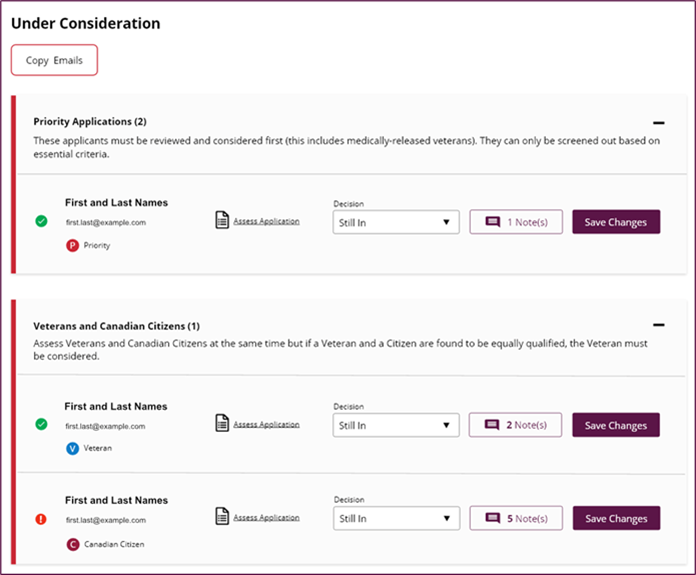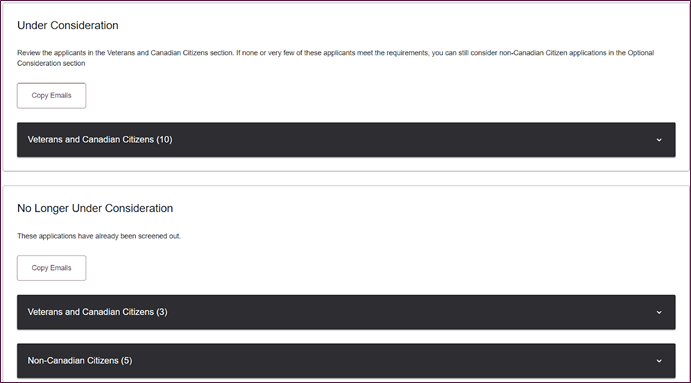At the heart of every hiring process are the applicants themselves. The applicant tracking tool was designed to present the list of applicants to managers in a way that made it easier for them to review and stay organised throughout the assessment phases of the staffing process.
Government of Canada hiring managers are required to consider applicants in a certain order, and this can vary depending on a manager’s department or agency. For example, Canadian citizens must be considered before non-Canadian citizens. In some departments, those with veterans and those with priority status must be considered first, whereas in other departments internal employees must be considered first. The applicant tracking tool organizes and groups applications in the order of consideration required by their department. If a manager changes departments, the applicant tracking system changes the order of consideration. This supports managers to sort applicants efficiently, and be policy compliant, without managers needing to think about requirements. Applicants are simply presented in the “flight” order in which managers need to consider them.
The tool keeps track of applications that have not been reviewed and reorganizes them as managers review and decide whether the applicant is qualified to proceed to the next assessment step. Applicants who are still being considered stay at the top of the “Under Consideration” category, while those who are screened out are moved to the bottom of the list. This automatic sorting helped managers and HR advisors to keep track of their assessment process and coordinate communications with applicants.
The sorting selection also allows managers to flag an application decision as “Still Thinking”, meaning that managers don’t get hung up on points of indecision. They can simply flag these files for later review, and move on to others where they can more easily determine if the applicant should proceed or be screened out. This is a behavioural intervention to prevent choice paralysis, which can lead to procrastination and longer staffing times.
The applicant tracking tool has been available to managers since early 2019 and HR advisors since early 2020 (when their respective portals were launched on the platform). The tool has limitations on detailed assessments of each applicant (by deliberate design) in order to comply with policy requirements related to the absence of a Protected B server environment. These limitations are ready to be removed and replaced with new features as soon as a Protected B server environment becomes available.
An upgraded new design has been developed to combine the applicant tracking tool with the record of decision (see section 4.14 A Tool for Record of Decision for more details). This upgraded design has not yet been released.
Managers reported that the tool made it significantly easier for them to keep track of and review applications. They found the auto-sorting to be convenient, and grouping of applications had in some cases helped managers to batch and prioritize applications they needed to review. Managers also appreciated being able to see the names and email addresses of all the applicants on a dashboard.
Managers also followed the behavioural designs around the choice architecture (to prevent choice paralysis and procrastination) as expected, which was a success in terms of reducing time to staff, particularly in the initial applicant screening stage of the hiring process.
After introducing a feature that allows managers to screen applicants in real time, as applications arrived, we also observed a reduction in time to staff for processes that took advantage of that feature (read Overall Impact on Reducing Time to Staff for more details).
Managers found the applicant tracking tool to be useful in the initial application sorting stage, and most continued to use it throughout the rest of the hiring process (even considering the required limitations on the platform that made assessment tracking less functional). Other managers and HR advisors tracked applicants in their own ways off platform as they continued the assessment process, signaling a need to link applicant tracking and record of assessment for users to utilize the tool from end to end. (This can only be implemented once the platform is successfully migrated into a Protected B server environment.)
As job opportunities on Talent Cloud were usually advertised for at least two weeks, the introduction of real time screening allowed managers to review applications as they arrived, which tended to coincide with the behavioural stage when managers were most eager to sort applicants. Having posted a job advertisement, managers wanted to see who was applying. Although this feature was introduced late in the pilot, managers that used it reported feeling less overwhelmed, and were more able to keep pace in screening when they were dealing with a few applications a day. This lower daily time draw, coupled with the enthusiasm to see who had applied each day, led to positive outcomes - both experientially and in terms of reducing time to staff.
There is research that suggests that making a large volume of assessment decisions at once can lead to decision fatigue, an excessive tendency to draw inferences from small points of data (thin slicing), and ultimately errors in judgement brought on by depleted mental energy reserves related to decision making capacity. The choice architecture in this tool is designed to promote best practices in decision making in three ways: sub-grouping without drawing on decision-making energy reserves, reducing choice paralysis, and reducing application volume in a single sitting through real time screening. In essence, it has been engineered to promote not only a faster staffing process, but also best practices in terms of generating fairness in decision making, based on the current behavioural science.

